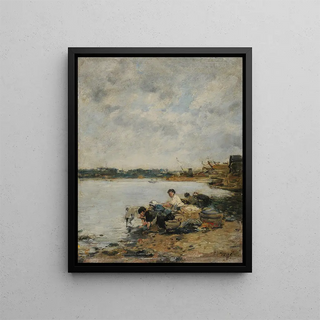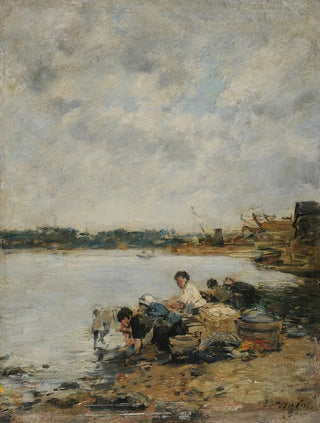Painting La Touques le matin - Eugène Boudin | Art print


View from behind

Frame (optional)
Art print La Touques le matin - Eugène Boudin – Engaging introduction
In the luminous world of Impressionist painting, "La Touques le matin" by Eugène Boudin stands out for its ability to capture the very essence of a fleeting moment. This artwork, created in the heart of Normandy's nature, delicately evokes the gentle serenity of a peaceful morning, where the reflections of light dance on the calm water of the river. The artist succeeds in conveying a serene, almost meditative atmosphere, inviting the viewer to immerse themselves in a landscape where time seems to stand still. The canvas, both vibrant and subtle, transports us to a moment of contemplation, revealing the ephemeral beauty of nature.
Style and uniqueness of the work
Boudin distinguishes himself with his unique approach to maritime landscapes, blending refined technique with a delicate color palette. In "La Touques le matin," the brushstrokes are both light and precise, creating a texture that suggests the movement of waves and the trembling of the air. Shades of blue and green blend harmoniously, while touches of golden light illuminate the canvas, emphasizing the freshness of the morning. The artist uses natural light as a character in its own right, giving it a crucial role in the composition. This poetic painting bears witness to his talent for capturing not only a landscape but also an emotion, an atmosphere, a sensation.
The artist and his influence
Eugène Boudin, often regarded as a precursor of Impressionism, managed to influence many artists of his time, including Claude Monet. His attachment to nature and his desire to depict it authentically led him to paint en plein air, a practice that would become emblematic of the Impressionist movement. Boudin always sought to immortalize light and air, two essential elements of his work. His painting technique, characterized by quick strokes and vibrant colors, paved the way for a new way of seeing the world. By exploring Normandy landscapes, he also contributed to the region's recognition, which became a source of inspiration for many artists. His legacy endures today, and his ability to capture

Matte finish

View from behind

Frame (optional)
Art print La Touques le matin - Eugène Boudin – Engaging introduction
In the luminous world of Impressionist painting, "La Touques le matin" by Eugène Boudin stands out for its ability to capture the very essence of a fleeting moment. This artwork, created in the heart of Normandy's nature, delicately evokes the gentle serenity of a peaceful morning, where the reflections of light dance on the calm water of the river. The artist succeeds in conveying a serene, almost meditative atmosphere, inviting the viewer to immerse themselves in a landscape where time seems to stand still. The canvas, both vibrant and subtle, transports us to a moment of contemplation, revealing the ephemeral beauty of nature.
Style and uniqueness of the work
Boudin distinguishes himself with his unique approach to maritime landscapes, blending refined technique with a delicate color palette. In "La Touques le matin," the brushstrokes are both light and precise, creating a texture that suggests the movement of waves and the trembling of the air. Shades of blue and green blend harmoniously, while touches of golden light illuminate the canvas, emphasizing the freshness of the morning. The artist uses natural light as a character in its own right, giving it a crucial role in the composition. This poetic painting bears witness to his talent for capturing not only a landscape but also an emotion, an atmosphere, a sensation.
The artist and his influence
Eugène Boudin, often regarded as a precursor of Impressionism, managed to influence many artists of his time, including Claude Monet. His attachment to nature and his desire to depict it authentically led him to paint en plein air, a practice that would become emblematic of the Impressionist movement. Boudin always sought to immortalize light and air, two essential elements of his work. His painting technique, characterized by quick strokes and vibrant colors, paved the way for a new way of seeing the world. By exploring Normandy landscapes, he also contributed to the region's recognition, which became a source of inspiration for many artists. His legacy endures today, and his ability to capture
12,34 €






